Restoring the Polk County Courthouse
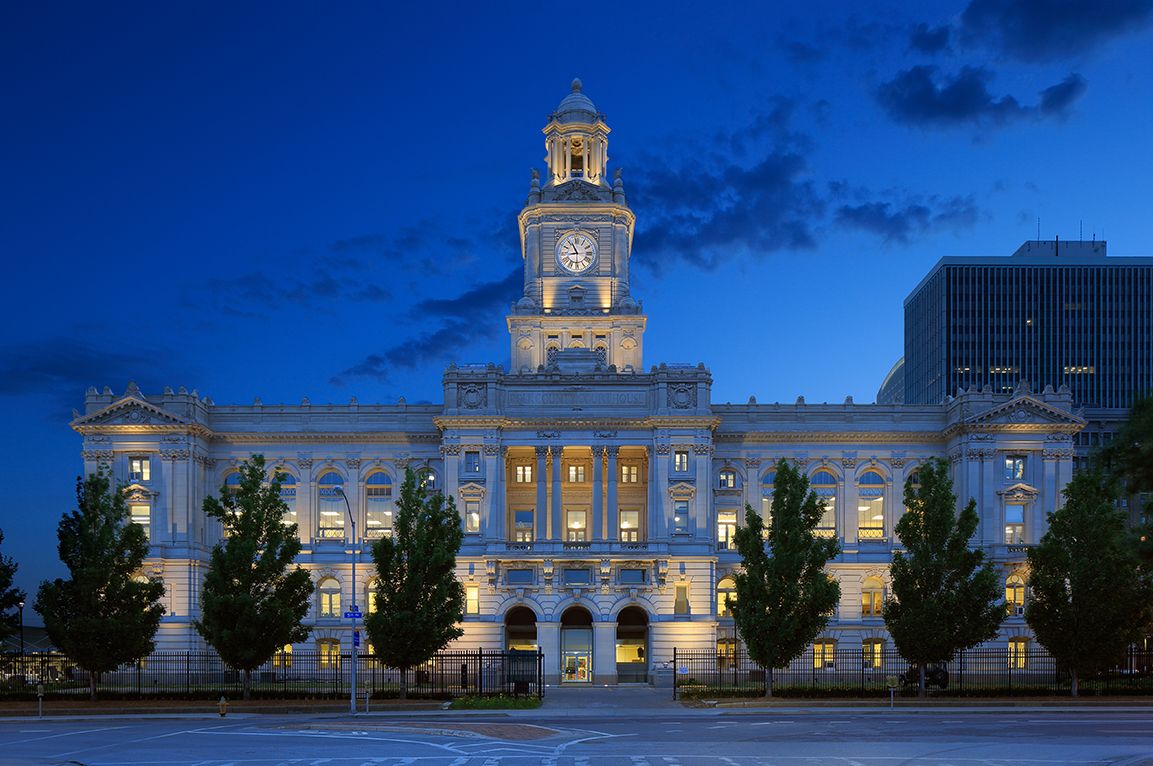
Project
Overview
Project Name
Polk County Courthouse
Size
37,000 GSF
Market Sector Details
Government, Historic Preservation
Team
OPN Architects
Timeless Beauty
Located just west of the Des Moines River in Iowa’s capital stands the Polk County Courthouse. A crown jewel of the city’s urban landscape, the Beaux-Arts architecture adds a unique dynamic to Des Moines’ assemblage of downtown structures. Added to the National Register of Historic Places in 1979, the Polk County Courthouse is a vital piece of Des Moines and Iowa’s history. Prior to the renovations, the building’s interior design did not match the building’s historically significant and classical exterior. The building’s original plaster walls and ceilings were covered and punctured to provide a mechanical mezzanine. Terrazzo flooring was covered with outdated carpets, which had been provided in renovations during the 1980s. Additionally, the uptick in foot traffic and the ever-evolving needs of the county government were outpacing the courthouse’s current interior provisions.
The project’s complexity also originated from the architect and contractor’s ambitious goals to ensure that MEP solutions did not provide visual obtrusions to the restored interiors. A phased approach during the renovation needed to be carefully coordinated in order to keep portions of the building functional while providing necessary infrastructure updates. In addition to this innovative project vision, Alvine worked on a section-by-section basis to determine proper horizontal and vertical integration, as the building’s original construction documents no longer existed.
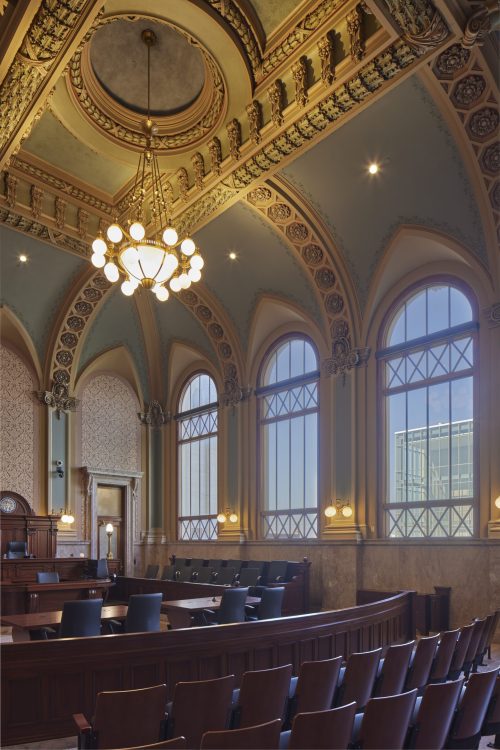
A Courthouse Restored
The architect and contractor went to great lengths to restore the long-lost beauty and aesthetic of the Polk County Courthouse. Drop ceilings were removed, and layers of paint were carefully stripped to restore the ornate painting and plasterwork across the north and south lobby as well as six historic courtrooms. Along with a complete restoration of the terrazzo flooring, strategically placed accents of red terrazzo hides necessary infrastructure vital for high-tech courtroom technology and power solutions.
Scagliola columns were noticeably chipped and damaged, and artisanal masonry experts were called upon to make repairs. Alvine’s lighting designers restored existing historic luminaires and replicated other historic luminaires in conjunction with the architect, using original imagery of the courthouse. Large, stained-glass windows spanning across the north and south lobby ceiling had to be meticulously deconstructed, restored, and set back in place. The previous treatment of the building’s plasterwork had to be restored by hand. While going to great lengths to restore the courthouse’s magnificence, the county government and architect desired MEP solutions to be functional and energy-efficient without detracting from the interior’s newly refined beauty. Our team worked in tandem with the project architect and contractor during the renovation process to design these innovative solutions.
“The architect and contractor did a fantastic job coordinating and executing the aesthetic repairs,” Jason Jones, the lead mechanical engineer involved with the project, stated. “Our goal was to provide the necessary infrastructure that will maintain the courthouse’s beauty for decades.”
Electrical and Mechanical Solutions
Our electrical team utilized a pre-existing tunnel between the adjacent criminal courts building and the courthouse to install a new electrical service and route new electrical systems from the previously constructed utility vault in the criminal courts building. New distribution panels were installed in the attic and basement to avoid public spaces. Long-forgotten masonry shafts inside the courthouse’s original brick walls were used for vertical integration. The HVAC system boasts a variable refrigerant flow system outfitted with heat recovery capabilities to share heat between spaces that are in cooling and spaces that are in heating. The central outside air units included energy recovery sections utilizing exhaust and relief air from the building to temper intake air, reducing the heat pump’s capacity and aiding its efficiency. Mechanical system connections used the same tunnel as a pathway for hydronic piping to serve heating and cooling needs. Cooling towers and boiler systems at the criminal courts building were sized to serve the historic courthouse.
“We spent a significant amount of time coordinating with code officials all the way down to local electrical inspectors,” Nick Andera, the lead project electrical engineer, stated, “We worked with these entities to determine acceptable solutions given how complex and unique the facility is.”
Limited space made it vital for two dedicated outside air handling units to be located in the basement. The air handling unit had to be taken apart and lowered into the building in sections, then reassembled due to tight spacing requirements. Refrigerant lines and ventilation/relief ductwork ran through the same chassis space as the new electrical routing for vertical integration. In some locations, existing masonry shafts were utilized for air pathways to keep historic wall materials intact. Thermostats were discreetly placed in low-traffic areas such as kitchenettes and break rooms, and integrated into judges’ desks in the courtrooms.
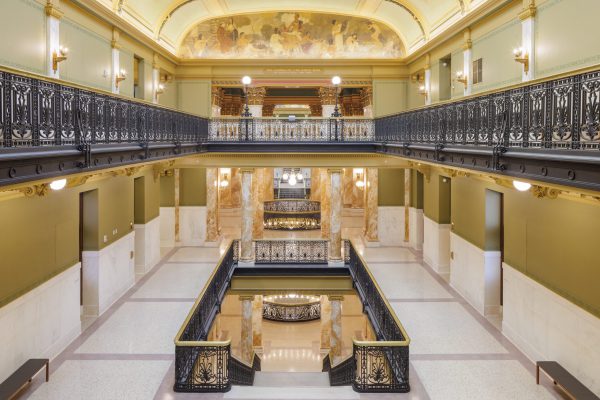
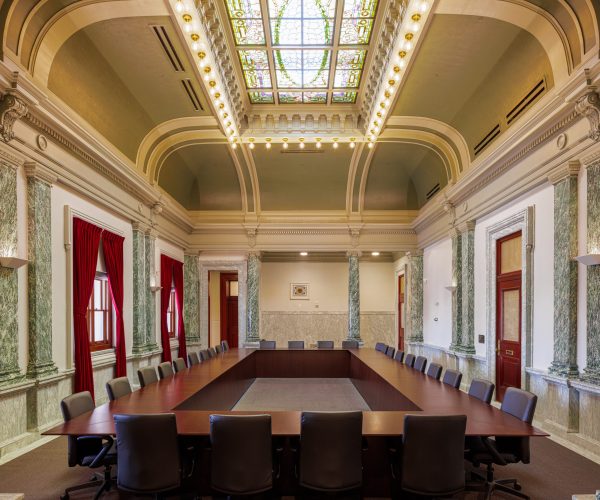
The original building had a combined storm and sanitary system that had to be separated as an objective of the project. An entirely new storm system was installed in the attic space and back-of-house areas, connecting to a new site connection. To chart routes for the domestic and sanitary plumbing and the storm piping, in accordance with the project team, our mechanical team supplied design and guidance onsite on a section-by-section scale. The ducts and pipework were implemented strategically to avoid historically significant areas, such as atriums and marble ceilings, while serving as a functional solution for the building. As the onsite contractor opened up different areas within the chassis spaces, our team thoroughly analyzed these areas and developed designs through close collaboration with the contractor. The new systems contributed to energy savings that outperformed code minimums by 43%, qualifying the courthouse for an energy rebate.
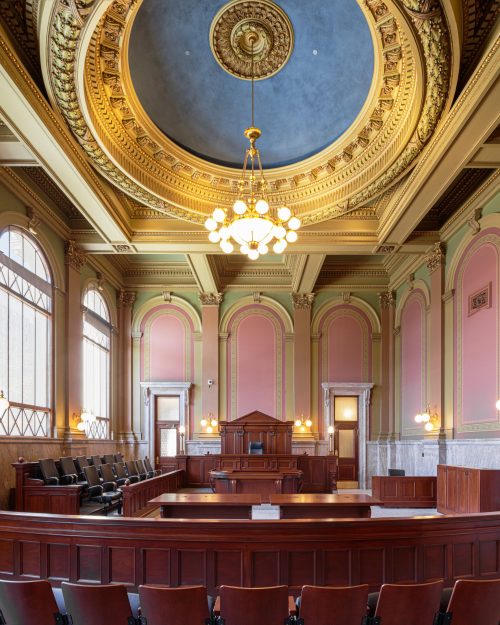
The Finished Product
Despite the unique challenges presented to the project team throughout the design and construction, the collaborative multidisciplinary process the project team utilized created solutions that have both restored the Polk County Courthouse’s beauty while ushering it into the 21st century.
“The constituents are getting the look of the original building with all of the benefits of a modern facility,” Nick Andera stated, “This will be able to aptly serve the Polk County community for generations.”
By maintaining as many of the original historic materials as possible throughout the construction process, the Polk County Courthouse retains its unique character.
“While the project was quite design-intensive, we restored the building back to its original glory,” Jason Jones finished, “While there were a lot of challenges along the way, it’s very rewarding to see the finished product.”
Interested in learning more about our historic preservation portfolio? Feel free to connect with our experts.



